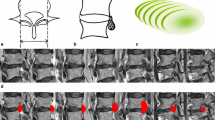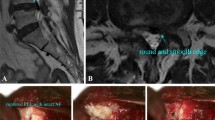Abstract
Purpose
Migrated lumbar disc herniations (LDHs) in the sagittal plane are common. Disc migration grading can be applied as a useful measurement tool in the diagnosis, treatment, and outcome evaluation of migrated LDH. No study has evaluated the reliability of migrated LDH grading. We evaluated the reliability and functionality of the current magnetic resonance imaging (MRI) grading system for migrated LDH.
Methods
We assessed a six-level grading system developed based on sagittal MRI and graded according to the direction (rostral and caudal) and degree (low, high, and very high) of disc migration. One-hundred and one migrated LDHs treated with minimally invasive endoscopic discectomy were analyzed independently by two experienced radiologists. Intraobserver and interobserver agreements were assessed by kappa statistics.
Results
The most common migrated LDH grade was grade 4 (30.94%; caudal, low-grade migration). Rostral and caudal migrations were more common in the upper and lower lumbar levels, respectively. Interobserver agreement in the grading of migrated LDH was good at both the first (kappa = 0.737) and second assessment (kappa = 0.657). The intraobserver agreement for reader 1 was very good (kappa = 0.827) and for reader 2 was good (kappa = 0.620).
Conclusions
The current grading system for migrated LDH was found to be reliable and functional with good interobserver and intraobserver agreement. It may be useful in the interpretation of disc migration patterns and outcomes of various minimally invasive surgical procedures.




Similar content being viewed by others
References
Fardon DF, Milette PC (2001) Combined Task Forces of the North American Spine Society, American Society of Spine Radiology, and American Society of Neuroradiology.. Nomenclature and classification of lumbar disc pathology. Recommendations of the Combined task Forces of the North American Spine Society, American Society of Spine Radiology, and American Society of Neuroradiology. Spine (Phila Pa 1976) 26(5):E93–E113
Daghighi MH, Pouriesa M, Maleki M, Fouladi DF, Pezeshki MZ, Mazaheri Khameneh R, Bazzazi AM (2014) Migration patterns of herniated disc fragments: a study on 1,020 patients with extruded lumbar disc herniation. Spine J 14(9):1970–1977. https://doi.org/10.1016/j.spinee.2013.11.056
Schellinger D, Manz HJ, Vidic B, Patronas NJ, Deveikis JP, Muraki AS, Abdullah DC (1990) Disk fragment migration. Radiology 175(3):831–836
Saruhashi Y, Omura K, Miyamoto K, Katsuura A, Hukuda S (1999) A migrated lumbar disc herniation simulating a dumbbell tumor. J Spinal Disord 12(4):307–309
Mobbs RJ, Steel TR (2007) Migration of lumbar disc herniation: an unusual case. J Clin Neurosci 14(6):581–584
Lee S, Kim SK, Lee SH, Kim WJ, Choi WC, Choi G, Shin SW (2007) Percutaneous endoscopic lumbar discectomy for migrated disc herniation: classification of disc migration and surgical approaches. Eur Spine J 16(3):431–437
Lee SH, Kang BU, Ahn Y, Choi G, Choi YG, Ahn KU, Shin SW, Kang HY (2006) Operative failure of percutaneous endoscopic lumbar discectomy: a radiologic analysis of 55 cases. Spine (Phila Pa 1976) 31(10):E285–E290
Schubert M, Hoogland T (2005) Endoscopic transforaminal nucleotomy with foraminoplasty for lumbar disk herniation. Oper Orthop Traumatol 17(6):641–661
Choi G, Lee SH, Lokhande P, Kong BJ, Shim CS, Jung B, Kim JS (2008) Percutaneous endoscopic approach for highly migrated intracanal disc herniations by foraminoplastic technique using rigid working channel endoscope. Spine (Phila Pa 1976) 33(15):E508–E515
Kim HS, CI J, Kim SW, Kim JG (2009) Endoscopic transforaminal suprapedicular approach in high grade inferior migrated lumbar disc herniation. J Korean Neurosurg Soc 45(2):67–73
Choi G, Prada N, Modi HN, Vasavada NB, Kim JS, Lee SH (2010) Percutaneous endoscopic lumbar herniectomy for high-grade down-migrated L4-L5 disc through an L5-S1 interlaminar approach: a technical note. Minim Invasive Neurosurg 53(3):147–152
Yeom KS, Choi YS (2011) Full endoscopic contralateral transforaminal discectomy for distally migrated lumbar disc herniation. J Orthop Sci 16(3):263–269
Kitahama Y, Sairyo K, Dezawa A (2013) Percutaneous endoscopic transforaminal approach to decompress the lateral recess in an elderly patient with spinal canal stenosis, herniated nucleus pulposus and pulmonary comorbidities. Asian J Endosc Surg 6(2):130–133
Ahn Y, Jang IT, Kim WK (2016) Transforaminal percutaneous endoscopic lumbar discectomy for very high-grade migrated disc herniation. Clin Neurol Neurosurg 147:11–17. https://doi.org/10.1016/j.clineuro.2016.05.016
Tonogai I, Sairyo K, Higashino K, Sakai T, Katoh S, Yasui N (2007) Minimally invasive endoscopic removal of a herniated nucleus pulposus that had migrated to the S1 nerve root foramen. Minim Invasive Neurosurg 50(3):173–177
Dezawa A, Mikami H, Sairyo K (2012) Percutaneous endoscopic translaminar approach for herniated nucleus pulposus in the hidden zone of the lumbar spine. Asian J Endosc Surg 5(4):200–203
Kim CH, Chung CK, Woo JW (2016) Surgical outcome of percutaneous endoscopic interlaminar lumbar discectomy for highly migrated disk herniation. Clin Spine Surg 29(5):E259–E266. https://doi.org/10.1097/BSD.0b013e31827649ea
Papavero L, Kothe R (2013) The translaminar approach for cranially extruded lumbar disc herniations. Oper Orthop Traumatol 25(1):6–15
Ikuta K, Tono O, Senba H, Kitamura T, Komiya N, Oga M, Shidahara S (2013) Translaminar microendoscopic herniotomy for cranially migrated lumbar disc herniations encroaching on the exiting nerve root in the preforaminal and foraminal zones. Asian Spine J 7(3):190–195
Landis JR, Koch GG (1977) The measurement of observer agreement for categorical data. Biometrics 33(1):159–174
Lee S, Lee JW, Yeom JS, Kim KJ, Kim HJ, Chung SK, Kang HS (2010) A practical MRI grading system for lumbar foraminal stenosis. AJR Am J Roentgenol 194(4):1095–1098. https://doi.org/10.2214/AJR.09.2772
Fries JW, Abodeely DA, Vijungco JG, Yeager VL, Gaffey WR (1982) Computed tomography of herniated and extruded nucleus pulposus. J Comput Assist Tomogr 6(5):874–887
Kim IS, Lee SW, Son BC, Sung JH (2008) Posterior epidural migration of thoracic disc fragment. J Korean Neurosurg Soc 43(5):239–241. https://doi.org/10.3340/jkns.2008.43.5.239
Dillon WP, Kaseff LG, Knackstedt VE, Osborn AG (1983) Computed tomography and differential diagnosis of the extruded lumbar disc. J Comput Assist Tomogr 7(6):969–975
Williams AL, Haughton VM, Daniels DL, Grogan JP (1983) Differential CT diagnosis of extruded nucleus pulposus. Radiology 148(1):141–148
An HS, Vaccaro A, Simeone FA, Balderston RA, O’Neill D (1990) Herniated lumbar disc in patients over the age of fifty. J Spinal Disord 3(2):143–146
Dammers R, Koehler PJ (2002) Lumbar disc herniation: level increases with age. Surg Neurol 58(3–4):209–212 discussion 212-3
Igarashi T, Hirabayashi Y, Shimizu R, Saitoh K, Fukuda H, Mitsuhata H (1997) The lumbar extradural structure changes with increasing age. Br J Anaesth 78(2):149–152
Acknowledgments
The authors would like to thank Ho Kim, BS, Jae Eun Park, BS, and Sol Lee, BS, for their support and assistance with this study.
Author information
Authors and Affiliations
Corresponding author
Ethics declarations
Funding
This research was funded by a grant of the Korea Health Technology R&D Project through the Korea Health Industry Development Institute (KHIDI), funded by the Ministry of Health & Welfare, Republic of Korea (Grant number HI16C2319).
Conflict of interest
The authors declare that they have no conflict of interest.
Ethical approval
All procedures performed in studies involving human participants were in accordance with the ethical standards of the institutional and/or national research committee and with the 1964 Declaration of Helsinki and its later amendments or comparable ethical standards. For this type of study formal consent is not required.
Informed consent
Informed consent was obtained from all individual participants included in the study.
Rights and permissions
About this article
Cite this article
Ahn, Y., Jeong, T.S., Lim, T. et al. Grading system for migrated lumbar disc herniation on sagittal magnetic resonance imaging: an agreement study. Neuroradiology 60, 101–107 (2018). https://doi.org/10.1007/s00234-017-1943-7
Received:
Accepted:
Published:
Issue Date:
DOI: https://doi.org/10.1007/s00234-017-1943-7




